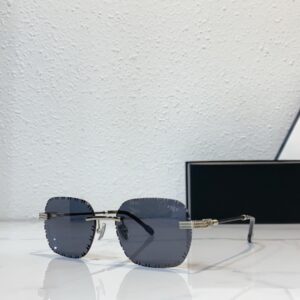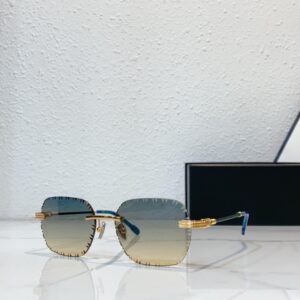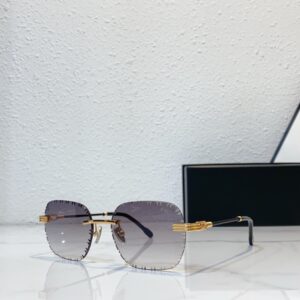The Rise of Sunglasses as a Status Symbol
Over the years, sunglasses have transcended their original purpose of providing protection against harmful UV rays to become a significant fashion accessory and a symbol of status. This transformation can be attributed to various cultural shifts, including the increased influence of celebrities and the evolving social landscape that has placed greater emphasis on personal branding and image. As society has moved toward valuing individuality and self-expression, the role of sunglasses has evolved accordingly, cementing their status as more than just an everyday item.
Celebrity endorsements have played a crucial role in this evolution. Icons of style, including film stars, musicians, and influencers, have adopted sunglasses as essential elements of their public personas. Brands such as Ray-Ban, Gucci, and Chanel have benefited immensely from this exposure, aligning their products with aspirational lifestyles. When a celebrity is seen wearing a particular pair of sunglasses, it instantly transforms that item into a coveted piece of fashion. This creates a ripple effect, leading fans and aficionados to seek out the same styles, often elevating the associated brand to cult status.
The psychology behind the desire to own designer sunglasses is rooted in the human inclination to signal wealth, taste, and social standing. Owning luxurious items often leads to a perceived elevation of one’s status, which can be particularly appealing in a competitive social environment. This psychological aspect not only affects purchasing decisions but also influences brands to market their products as exclusive and prestigious. Certain brands have become synonymous with luxury, marking a clear distinction between replicas and original designs. The allure of unique craftsmanship and prestigious heritage attracts consumers who aim to reflect their own aspirations and lifestyle choices through their sunglasses.
Understanding Replicas: The Allure of Imitation
Replicas in the sunglasses market refer to imitation products designed to closely resemble original designer eyewear, often boasting similar aesthetic characteristics at a significantly reduced price. The appeal of replicas stems primarily from their affordability, allowing consumers who desire a trendy or luxurious look to access such styles without the financial burden of purchasing authentic designer sunglasses. The price difference can be substantial; while genuine designer sunglasses may range from several hundred to thousands of dollars, replicas can be found at a fraction of that cost, making them highly attractive to budget-conscious buyers.
Moreover, marketing plays a critical role in shaping consumer perceptions regarding replicas. Some brands have effectively leveraged social media and influencer collaborations to showcase replicas as fashionable alternatives, contributing to a growing acceptance of imitation products. This promotional approach often emphasizes the idea that style can exist independently from brand prestige, leading potential buyers to gravitate towards replicas as viable options to keep up with fashion trends.
The moral implications of purchasing these imitative products cannot be disregarded. While some consumers view replicas as a harmless way to access the luxury market, others argue that such practices undermine authentic brands and discourage innovation within the industry. Critics maintain that by opting for replicas, consumers may inadvertently contribute to an economy that devalues original products and erodes the framework of artistic expression inherent in high-quality design.
Real-world examples of popular replica sunglasses include versions of iconic styles like the Ray-Ban Wayfarers and the oversized Gucci sunglasses. These replicas demonstrate the extensive diversity within the market, where consumers are presented with multiple choices that mimic current trends. As the demand for affordable yet stylish eyewear continues to grow, the allure of replicas remains a potent force in shaping consumer purchasing behavior.
The Appeal of Original Sunglasses
The allure of original sunglasses extends far beyond mere aesthetics. Consumers are often drawn to authentic eyewear due to the high level of craftsmanship involved in their production. Quality materials, meticulous attention to detail, and innovative design contribute significantly to the value of original sunglasses. Renowned brands invest in superior craftsmanship to ensure durability and comfort, factors that synthetic replicas often overlook. As a result, individuals are willing to pay a premium for these features, knowing they are making a long-term investment that will withstand the test of time.
Brand heritage plays an equally important role in the appeal of original sunglasses. Luxury brands such as Ray-Ban, Chanel, and Gucci have cultivated a rich history, becoming synonymous with not only eye protection but also an aspirational lifestyle. This storied past adds depth to the consumer’s experience, as owning a pair of originals often carries a sense of pride and connection to the brand’s legacy. Fashion experts highlight that this emotional connection transforms sunglasses into more than just functional accessories; they become symbols of identity and social standing that embody a unique narrative.
Unique designs further distinguish original sunglasses from their replicas. Each limited-edition release or signature model represents a fusion of artistic expression and brand innovation, making them coveted items for fashion enthusiasts. Replicas, while visually similar, lack the distinct character and novelty that originals portray, rendering them less appealing to discerning consumers. The authenticity represented by these originals resonates particularly well within luxury consumer circles, where the pursuit of genuine products often reflects an appreciation for artistry and appreciation of fashion history.
In light of these considerations, it becomes clear that the appeal of original sunglasses is multi-faceted. The investment in quality craftsmanship, the allure of brand heritage, and the unique designs make the ownership of originals a compelling choice for those seeking both functionality and status.
Climate Change and Its Influence on Sunglasses Styles
Climate change has a tangible impact on various aspects of daily life, including the fashion industry and eyewear, particularly sunglasses. As global temperatures continue to rise, the associated increase in ultraviolet (UV) radiation necessitates changes in sunglasses styles and materials. Consumers are increasingly seeking sunglasses that not only offer protection against UV rays but also align with their values toward sustainability and environmental responsibility.
Recent fashion trends have shown a noticeable shift toward designs that prioritize enhanced UV protection and durability. Brands are responding to the heightened awareness of skin cancer and ocular health associated with increased sun exposure. As a result, sunglasses with wider lenses and wrap-around styles are becoming more popular, providing better coverage against harmful rays. The use of advanced lens technologies, such as polarized lenses, has also surged, offering improved clarity and reduced glare, making them a practical choice for environmentally conscious consumers.
The materials used in the production of sunglasses are also witnessing a transformation influenced by climate concerns. Traditional plastic frames have come under scrutiny due to their non-biodegradable nature. In response, leading brands are increasingly adopting eco-friendly materials, like recycled plastics and bio-based alternatives, which mitigate environmental harm. This move towards sustainable practices helps brands to appeal to a growing market segment that prioritizes eco-friendly choices in their purchasing decisions.
Moreover, as consumers become more attuned to the effects of climate change, the demand for transparency about sourcing and manufacturing processes is rising. Brands that can effectively communicate their commitment to sustainable practices are likely to gain a competitive edge. Thus, the sunglasses market is evolving, reflecting broader climate change trends while addressing the demands of eco-conscious consumers.
Sunglasses Trends Around the Globe: A Climate Perspective
The influence of climate on sunglasses styles is a fascinating aspect of global fashion. Regions with sunnier and brighter climates tend to gravitate towards polarized lenses, which reduce glare from reflective surfaces like water and roads. This trend is particularly pronounced in coastal areas or regions with strong sunlight exposure, where outdoor activities are a frequent part of lifestyles. In contrast, places with overcast weather may prioritize comfort and fashion over lens functionality, leading to a preference for lighter tints and stylish frames that may not necessarily offer UV protection.
In addition to the climate, cultural factors also play a significant role in shaping sunglasses trends. For instance, in regions where the sun is a year-round companion, luxury sunglasses brands thrive, seen as markers of status and sophistication. High-quality original sunglasses are often viewed as an investment in personal style that transcends mere protection from the sun. These preferences can be starkly contrasted with areas where the climate does not necessitate constant use of sunglasses, leading to the tendency of opting for more affordable replicas that still convey a sense of style.
Moreover, the approach to replicas versus originals varies significantly based on local attitudes towards luxury and authenticity. In markets where luxury brands hold significant cultural value, the inclination may be to invest in authentic sunglasses to project a certain image of success and prestige. On the other hand, in regions where economic constraints are more pronounced, replicas can become a practical alternative, allowing individuals to maintain fashion sensibilities without the financial burden of original high-end brands. Therefore, analyzing regional sunglasses trends through the lens of climate and cultural values provides insights into the diverse preferences and purchasing behaviors of consumers worldwide.
Consumer Attitudes: How Status Affects Choices
Consumer attitudes towards sunglasses, particularly the choice between replicas and originals, are profoundly influenced by perceptions of status and identity. Numerous surveys indicate that brand loyalty plays a critical role in these purchasing decisions. Luxury brands, seen as status symbols, often create a sense of exclusivity that appeals to consumers’ desires for social recognition. This aspiration toward ownership of original products leads to a clear delineation between those who opt for high-end sunglasses and those who settle for replicas—often perceived as inferior alternatives.
Research suggests that individuals derive a significant part of their self-identity from their consumption choices, particularly in lifestyle products like sunglasses. The psychological association between high-status brands and an elevated social standing encourages consumers to prioritize authenticity over affordability. However, the growing trend of sustainability awareness has introduced a complex dynamic into the decision-making process, as more people are becoming mindful of the environmental impacts associated with luxury product consumption.
Moreover, cultural attitudes toward visibility and sustainability further shape these preferences. Some consumers view the purchase of replica sunglasses not as a compromise but as a practical, environmentally friendly choice—an assertion of their values in the face of consumerism. Marketing strategies leveraging sustainability narratives can significantly affect luxury spending patterns, particularly among younger demographics who prioritize eco-conscious brands but are also influenced by peer perceptions and social media visibility.
In conclusion, the interplay between status, identity, and sustainability greatly impacts consumer choices regarding sunglasses, illustrating a nuanced relationship between consumer psychology and brand perception in the luxury market. This evolving landscape continues to challenge traditional norms of consumption as individual and cultural values shift in the contemporary climate.
The Future of Sunglasses: What’s on the Horizon?
The future of sunglasses appears to be shaped by a myriad of factors that intertwine fashion trends, climate change, and evolving consumer attitudes. As the effects of climate change become more pronounced, there is an increasing demand for sustainable products across various industries, including the eyewear sector. Consumers are becoming more conscious of their purchasing decisions, leading to a heightened interest in sunglasses made from eco-friendly materials. Manufacturers are likely to respond with innovations such as biodegradable plastics and recycled materials, which could significantly alter the landscape of sunglasses production.
Moreover, designer brands may start to adopt more transparent marketing strategies to illustrate their commitment to sustainability. Limited-edition collections emphasizing environmentally responsible materials could appeal to both traditional luxury consumers and eco-conscious buyers. This divergence in consumer consciousness suggests that replicas might struggle to compete with originals, particularly those that highlight sustainable practices. One potential innovation could involve smart sunglasses that offer augmented reality features, blending functionality with fashion while staying aligned with consumer expectations for modern accessories.
Fashion cycles rapidly, and emerging trends could redefine sunglasses design. For instance, a resurgence in bold and unconventional shapes might captivate younger generations, pushing original brands to cater to unique tastes while remaining mindful of their environmental impact. Additionally, social media’s influence on fashion trends will persist, driving demand for sunglasses that not only serve a functional purpose but also act as a means of self-expression.
In conclusion, the future of sunglasses is poised for a transformative shift, embracing sustainability, innovation, and individuality. As brands adapt to the evolving landscape, the balance between replicas and originals will lean increasingly towards those that prioritize environmental responsibility and innovative design.
Caring for Your Sunglasses: Originals vs. Replicas
The care and maintenance of sunglasses are crucial for preserving their functionality and aesthetics, whether they are original designer models or budget-friendly replicas. Understanding the differences in materials and construction between these two types can help inform the best practices for cleaning, storage, and maintenance.
For original sunglasses, typically made from high-quality materials such as polycarbonate lenses and premium metals or plastics, it is essential to handle them with care. To clean these sunglasses, use a microfiber cloth and a gentle lens cleaner specifically designed for optical surfaces. Avoid using paper towels or clothing that could scratch the lenses. Regularly wiping down the frames, especially if they have ornate designs, will prevent dirt accumulation.
In contrast, replica sunglasses may be made from inferior materials that could be more susceptible to damage. As such, it is advisable to limit the use of harsh cleaners or rough fabrics to avoid scratching or warping the lenses. Instead, warm water and a mild soap solution can be effective for cleaning, followed by carefully drying with a soft cloth.
Proper storage is another significant factor that affects the longevity of sunglasses. Original pairs are often sold with a protective case; using this can safeguard them from scratches and impacts. For both originals and replicas, storing glasses in a designated spot, away from direct sunlight and high temperatures, will help maintain their structure and color. It’s also wise to avoid leaving them in vehicles, especially during warmer months.
Investing in original sunglasses also necessitates regular maintenance check-ups to identify any looseness in hinges or damage. If any issues arise, a professional can often provide repairs that are not possible with cheaper alternatives. By following these care guidelines, wearers of both original and replica sunglasses can enjoy extended durability and style.
Conclusion: The Intersection of Fashion, Climate, and Status
In contemporary society, sunglasses have transcended their utilitarian purpose, emerging as potent status symbols that reflect personal style and consumer values. The intricate interplay between the allure of original brands and the accessibility of high-quality replicas raises critical questions about authenticity, economic disparity, and consumer behavior. Original sunglasses often carry a sense of prestige, embodying craftsmanship, and brand heritage, while replicas offer a more affordable option that can mimic the aesthetics of their superior counterparts. This debate draws attention to broader issues of inequality and ethical consumption in fashion.
Additionally, the environmental impact of sunglasses production cannot be overlooked. Climate change increasingly influences fashion trends, steering consumer preferences toward sustainable materials and practices. As awareness grows regarding the ecological footprints of luxury items, consumers are prompted to make more conscious choices. Emphasizing sustainability, brands that prioritize eco-friendly manufacturing and materials are likely to resonate more with today’s environmentally conscious audience.
Furthermore, regional climate factors also shape consumer behavior, with different styles, colors, and functionalities becoming popular in varied geographical contexts. For instance, areas with intense sunlight may foster a demand for more polarized and protective eyewear, while fashion-forward locales might lean towards cutting-edge designs that serve to enhance social status. This dynamic illustrates how climate influences not only functionality but also the perceived value of sunglasses as a statement piece.
In conclusion, the relationship between sunglasses, status, and climate is complex and multifaceted. As consumers navigate this landscape, it is essential to foster critical thinking about the implications of their purchases. Prioritizing conscious consumerism that encompasses ethical considerations and environmental sustainability can elevate personal choice to an act of responsibility. Such awareness helps shape a more authentic and responsible approach to fashion, ensuring that optical aesthetics contribute positively to both personal identity and global ecological health.




